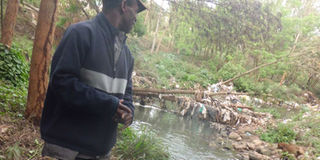Pollution of oceans and seas harming aquatic life

Acontaminated stream in Nairobi that runs into Lake Victoria. Photo by Lominda Afedraru
Plastic waste in seas and oceans is now a global issue that can no longer be ignored it is becoming a challenge in marine environment and this challenge can only be solved through joint effort by scientists, business people, governments and concerned stakeholder
Scientists globally are carrying out research to get better understanding of risks involved in Oceans and seas plastic pollution yet international opposition to it is growing.
The director of Leibniz Institute for Baltic Sea Research and Chair of the Germany Marine Research Consortium (KDM) Prof Ulrich Bathman giving overview about German Marine Research to Science Journalists at the Institute in Bremerhaven noted that plastic pollution in oceans and seas in Europe are a big a challenge.
These plastics include synthetic textiles, car tyres, city dust, road markings, marine paints and coatings, plastic for packaging cosmetic products and personal care products and plastic pellets among others.
These include micro plastics which have not been only found in water bodies but in bivalve marine organisms, marine aquatic species such as crabs, lobsters, crayfish, shrimp, krill, woodlice, fish and sea birds although not at a high level because they have the ability to excrete tiny plastic pieces which they might swallowed.
Others are Macro plastic types which include plastic bags, bottles, fish nets and plastics containers used in industries and agriculture sector among others.
Prof Ulrich explained that Scientists have been carrying out research in micro plastic in oceans and seas for so many years and they have discovered that some micro plastics take over 500 years to break down under water, some get corroded by the microorganism in the sea waters thereby becoming dangerous to aquatic life.
In the research work scientist in Germany are involved in, he notes that they have been collecting data in marine research for about 55 years and this data goes to a common pool which is shared.
This particular one on micro plastic is to investigate the genetic lifespan and how it affects aquatic life in the oceans and seas
The discoveries indicate worms living under water feed on them and digest them releasing fico matter into the water which may be unhygienic.
Other challenges are releasing chemicals originating from these plastics directly into the seas and oceans.
Chemical industries in Germany are not in position to release such information and it is the duty of scientists to find out by studying everything with funding obtained from these industries.
They have to study which plastics are degradable with end products not harmful to both human beings and aquatic life and the entire environment.
According to Prof Ulrich this study is not only carried in Germany but there is collaboration with scientists specialized in research in fresh water bodies mainly in Africa where water pollution from plastics is a huge challenge.
In Germany and other parts of Europe sharing shore lines with Baltic Sea, it is a huge challenge because there are a lot of shipping containers where sometimes plastics end up dumped in the sea.
At the Swedish coast of the southern Scandinavian Peninsula the incidence is rather overwhelming because of tourism activities where tourists end up dumping plastic bottles and cosmetic material in the sea shore.
Challenges and alternative solutions
This is a challenge to the fishing community running out of business instead of catching fish, they end up catching a mixture of fish and plastic material.
Secondly fishing in the oceans and seas may become unsafe coupled with secondary diseases affecting marine species there by affecting the health of seas food.
Scientists usually advice governments to invest money in establishing preventive measures by sensitizing people to avoid dumping these plastic material in water and what is already in water must be removed through a deliberate initiative.
Since the year 2013 the Germany government has been in dialogue with cosmetics industries on voluntary withdrawal from use of micro plastics for cosmetics products and the negotiations are still ongoing.
One of the biggest problems with micro plastic particles is that they are difficult to contain once they enter the marine environment because of their small size and ability to float.
Once they reach the sea, the surface of the particles often become colonized by micro-organisms, which alter the properties of the plastic, causing it to sink through the water column and become embedded in the seabed, shoreline, and plant matter. Clean-up operations thus become labour intensive, time consuming and costly.
History of plastic manufacturing and statistical data
In a publication Fauna and Flora International in UK, the origin of plastic manufacturing is dated back in 1900 and derived from crude oil fractions described as polymers long chains of repeating units which can be moulded and shaped for a wide variety of applications ranging from clothing and packaging in aircraft and even spacecraft components.
It is stated that there are many different types of plastic, but generally they can be grouped into two main polymer families: thermoplastics which soften on heating and then harden again on cooling and thermosets which can only be moulded once, so must be stored in liquid form prior to manufacturing.
During the production of plastics, additional chemicals are often added, many of which are toxic.
It further states that the scale and quantity of plastic production is truly staggering and Europe estimates that global plastic production now exceeds 280 million tons each year valued at over 1 trillion US dollars.
To make matters worse, the emphasis on disposable goods means that only around a third of plastic products are recovered for reuse and recycling.
Much of the remaining plastic debris makes its way into the world’s seas and oceans and is one of the most common components of marine litter.
Macro plastic pollution according to the publication poses severe, well publicized problems for marine fauna with over 200 marine species known to suffer from entanglement or ingestion, which can lead to choking and physical blockages, malnutrition and even death.
In all cases, once consumed, these particles can lead to physical blockages, malnutrition, choking and even starvation. Several studies have shown some seabirds even regurgitate micro plastics to their young during feeding.
Plastics have also been proven to adsorb persistent, bio accumulating and toxic chemicals such as DDT, while toxic additives used during the production and manufacturing stages of plastics are likely to leach out over time.
Some of these toxic additives already present in the marine environment are known to accumulate and magnify up the food chain. This has significant implications for global ecosystems, fisheries and human health.
From a recent UN report challenges posed by plastics as pollutants in oceans, it is stated that an estimated 10% of all marine debris is lost in water bodies. Many are a result of abandoned fishing gear such as fish nets, ropes, lines and traps. They are made of robust plastic materials that for an array of reasons have ended up in the sea.
What is ongoing in Uganda’s fresh water Lakes and Rivers?
In Uganda’s major fresh lakes such as Lake Victoria, Albert, George and Edward including River Nile the problem is equally the same.
Mr Bob Nuwagira, the senior communications and information officer at Uganda’s National Environment Management Authority (Nema) explains that although there is no clear documentation about the level of plastic pollution in our fresh water bodies, it is a serious challenge with the drainage facilities in the city centre as major contributor
All the plastic materials that end up in the drainage channels are usually swept by flowing water during heavy tropical down pour into the water bodies.
He explains that people have encroached on the wetlands along the shores of these lakes which are meant as drainage sewers but this is no longer the case causing a lot of allege in the waters. This can be seen along Gaba landing site at Lake Victoria not far away from the city centre.
The challenge in Lake Victoria is huge because the Nakivubo channel, the biggest in the city drains plastics bottles and bags in all sizes into the lake. The pollution in other lakes is mainly caused by fishing activities including abandoned fish nets.
Plastic pollution in Uganda and the rest of Africa to him is a two way, in the water bodies and land surface because some land locations meant for agriculture is littered by plastic bottles and bags.
It is a challenge to marine life because fish species such as Nile Perch which are huge in size end up consuming these plastics causing death.
Nema is in the process of pushing Uganda government to impose ban on plastic production and importation into the country. The Authority according to Nuwagira has written a report to Uganda’s cabinet about the dangers caused by plastic pollution to marine life and the land and the need to ban the same.
[email protected]




